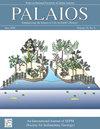鱼类化石埋藏学对密尔沃基下组沉积环境的启示(中泥盆世晚期berthelet组)
IF 1.5
4区 地球科学
Q2 GEOLOGY
引用次数: 1
摘要
摘要/ Abstract摘要:中泥盆世(Givetian)密尔沃基组最新的化石泥质白云岩中含有丰富的分离鱼类骨骼元素。本研究通过对该鱼类组合的分类分析,完善了密尔沃基组沉积环境的重建。强壮的骨骼元素,如平皮动物的磨牙、鳍棘和铠甲层,主导了这一组合。标本表现出不同的埋藏属性,包括颜色、光泽、腐蚀(化学腐蚀和/或物理磨损)、黄铁矿和磷酸盐过矿化以及表面生物的存在。罕见出现的牙齿属于骨鱼鱼类也有不同的音标。相关的无脊椎动物种类繁多,包括丰富的头足类内霉菌和黄铁矿化的腕足类,通常在壳散列中随机分布。总而言之,这些观测结果表明,在正常波基和风暴波基之间的大陆架上有沉积。在低能量背景时期,暴露在海底的鱼板将经历最初的关节脱落、表面附着、改变颜色和光泽的腐蚀和磷化。埋藏的骨骼元素被“保护”免受表面生物附着和腐蚀,但偶尔底物中的低氧条件导致早期成岩黄铁矿过矿化。周期性的高能量风暴事件导致了埋藏的骨骼元素(以及其他埋藏的骨骼元素)的完全断裂,以及重新加工和重新暴露,从而产生了具有广泛埋藏属性的时间平均组合。强健的板皮动物骨骼元素最适合在这种环境中存活下来,因此,以板皮动物为主的化石组合似乎是埋藏学过程和沉积环境能量的产物。本文章由计算机程序翻译,如有差异,请以英文原文为准。
INSIGHTS FROM FOSSIL FISH TAPHONOMY INTO THE DEPOSITIONAL ENVIRONMENT OF THE LOWER MILWAUKEE FORMATION (BERTHELET MEMBER, LATEST MIDDLE DEVONIAN)
Abstract: The fossiliferous, argillaceous dolostone of the latest Middle Devonian (Givetian) Milwaukee Formation contains abundant disarticulated fish skeletal elements. This study refines depositional environment reconstruction of the Milwaukee Formation through taphonomic analysis of this fish assemblage. Robust skeletal elements of placoderm grinding teeth, fin spines, and armored plating dominate the assemblage. Specimens display variation in taphonomic attributes including color, luster, corrasion (chemical corrosion and/or physical abrasion), presence of pyrite and phosphate permineralization, and epibionts. Rare occurrences of teeth belonging to osteichthyan fish are also taphonomically variable. Associated invertebrates are diverse and include abundant cephalopod internal molds and pyritized brachiopods often randomly oriented in shell hashes. In sum, these observations suggest deposition on a marine shelf between normal and storm wave base. During low-energy background periods, fish plates exposed on the seafloor would undergo initial disarticulation, epibiont attachment, and color- and luster-altering corrasion and phosphatization. Buried skeletal elements were ‘protected’ from epibiont attachment and corrasion, but occasional low oxygen conditions in the substrate led to early diagenetic pyrite permineralization. Periodic high-energy storm events were responsible for complete disarticulation as well as reworking and reexposure of buried skeletal elements (and burial of others), resulting in a time-averaged assemblage with a wide range of taphonomic attributes. Robust placoderm skeletal elements were best suited to survive fossilization in this setting and therefore the placoderm-dominated fossil assemblage appears to be an artifact of taphonomic processes and energy of the depositional environment.
求助全文
通过发布文献求助,成功后即可免费获取论文全文。
去求助
来源期刊

Palaios
地学-地质学
CiteScore
2.80
自引率
12.50%
发文量
40
审稿时长
6 months
期刊介绍:
PALAIOS is a monthly journal, founded in 1986, dedicated to emphasizing the impact of life on Earth''s history as recorded in the paleontological and sedimentological records. PALAIOS disseminates information to an international spectrum of geologists and biologists interested in a broad range of topics, including, but not limited to, biogeochemistry, ichnology, paleoclimatology, paleoecology, paleoceanography, sedimentology, stratigraphy, geomicrobiology, paleobiogeochemistry, and astrobiology.
PALAIOS publishes original papers that emphasize using paleontology to answer important geological and biological questions that further our understanding of Earth history. Accordingly, manuscripts whose subject matter and conclusions have broader geologic implications are much more likely to be selected for publication. Given that the purpose of PALAIOS is to generate enthusiasm for paleontology among a broad spectrum of readers, the editors request the following: titles that generate immediate interest; abstracts that emphasize important conclusions; illustrations of professional caliber used in place of words; and lively, yet scholarly, text.
 求助内容:
求助内容: 应助结果提醒方式:
应助结果提醒方式:


